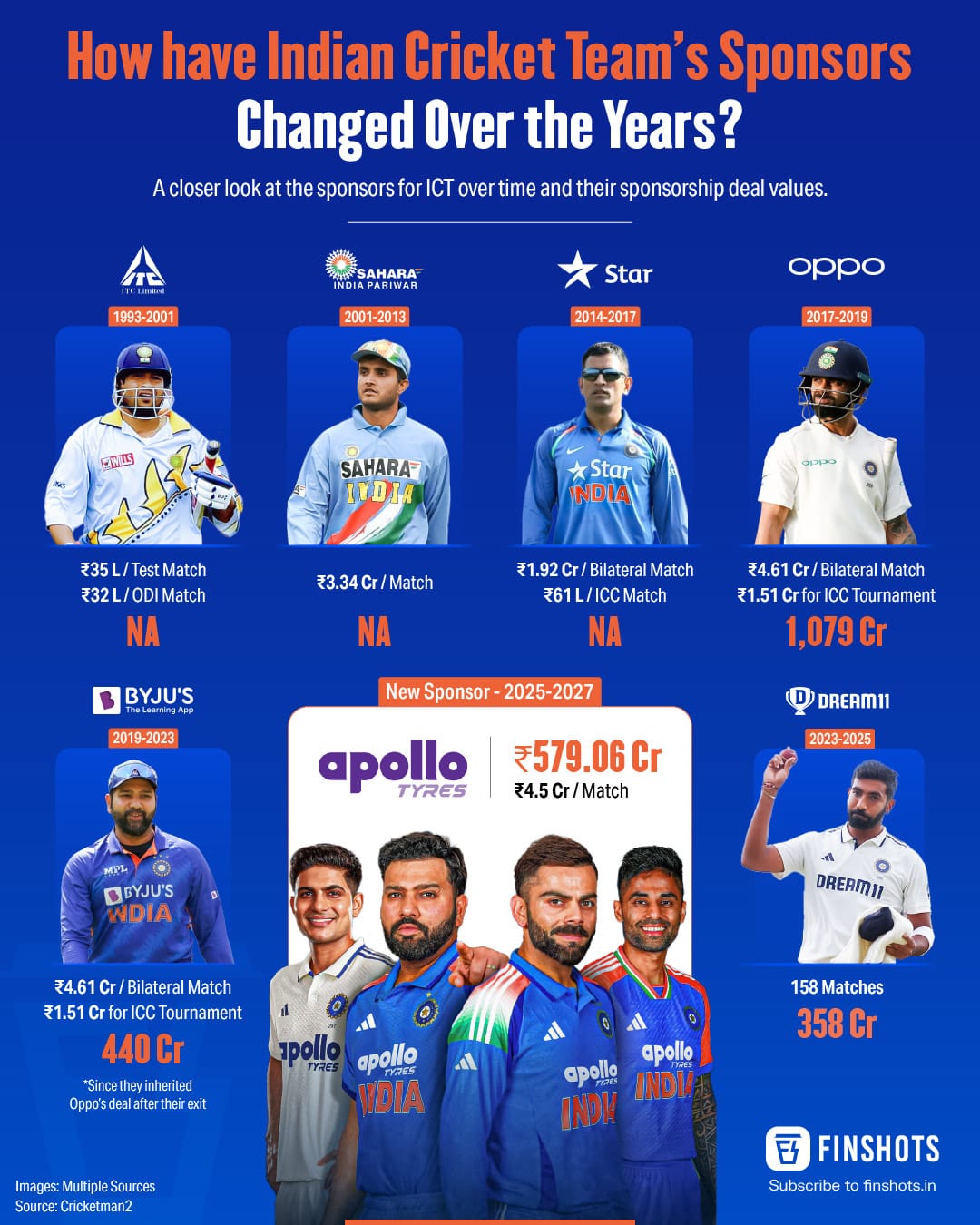Ctrl+C, Ctrl+V Polo, a Nobel for smelly research and more...

Hey folks!
Two Indian engineers, Vikash Kumar and Sarthak Mittal, just bagged the Ig Nobel Prize in Engineering Design.
Wait… isn’t the Nobel Prize 2025 announcement still a couple of weeks away?
Yup, it is. But notice we said Ig Nobel, and not Nobel.
So what’s the Ig Nobel, you ask?
Think of it as the Nobel’s cheeky cousin. It’s a satirical prize set up in 1991 by Marc Abrahams, editor of the Annals of Improbable Research, to honour research that first makes you laugh, then makes you think. Hence the name “Ig Nobel” as a play on the word “ignoble”.
And this year’s winners definitely live up to that brief.
- The Ig in Psychology went to a study on what happens when you tell narcissists, or just anyone, that they’re intelligent.
- The Ig in Nutrition went to research on which pizza toppings rainbow lizards prefer.
- The Ig in Biology went to a bunch of Japanese scientists who found that cows painted with zebra-like stripes were less likely to be bitten by flies.
- And the Ig in Peace, to research showing that a little alcohol can actually improve your pronunciation in a newly learned foreign language.
Oh, and in case you’re wondering about the findings: yes, just being told that you’re smart, whether it’s true or not can make you more narcissistic, zebra-painted cows got nearly 50% fewer fly bites, rainbow lizards at a resort in Togo love four-cheese pizza, and booze may help improve the pronunciation of people who newly learn a foreign language.
The list is long, but let’s get to the main one. What did our Indian engineers win for?
Their research looked at how foul-smelling shoes ruin the otherwise pleasant experience of using a shoe rack. Quirky? Absolutely. And prize-worthy? You bet.
But while the Igs celebrate funny and unusual studies, the winners are serious researchers — professors, scientists, and yes, even engineers. In fact, the prizes are often even handed out by real Nobel laureates.
So, sure, the Ig Nobels sound like a joke. But in reality, they celebrate imagination, curiosity, and the lighter side of science.
On that note, got any wacky research idea that could make you eligible for the Igs? Who knows… the next one could have your name on it.
Here’s a soundtrack to put you in the mood 🎵
Chaand Aawara by Swanand Kirkire, Shrey Gupta, and Khwaab
You can thank our reader, Ritik Agarwal, for this soothing rec.
What caught our eye this week 👀
Copy, Paste, Polo
Polo is no ordinary sport. You need skill to swing a 4-foot mallet at 60 km/h, strategy to outsmart the other team, and athleticism as rider and horse sprint across a field nearly three times the size of a football pitch. Add 500-kg animals and a ball barely bigger than an orange, and precision becomes key.
The rules are simple: score by driving the ball through the goalposts, switch ponies every few minutes, and don’t cross your opponent’s line of play. Simple, yet full of ritual and flair — it’s why many call it the ‘game of kings.’
But the kingmaker in polo isn’t the mallet or the man. It’s the horse. Players rotate between 8–12 ponies per match, swapping after each “chukker”. A strong string of ponies means rhythm, stamina, and a bond with the rider. Nobody showed this better than Adolfo Cambiaso, the Argentine polo GOAT, whose mare Cuartetera was once hailed as the best of her generation.
When Cuartetera died in 2023, Cambiaso didn’t just lose a pony. He lost his partner. And he wanted her back. So he turned to somatic cell nuclear transfer (SCNT) — better known as cloning or copy-paste cloning. The science is profound. You take a skin cell from the horse, extract the nucleus, (which contains its full genetic code) and place it into an egg cell from a donor mare that’s been emptied of its own DNA. Then zap it with a little electrical charge, and that egg is tricked into behaving like a fertilized embryo. And after 11 months, a foal is born—a near-identical twin of the original!
Cambiaso produced six such clones and rode them to victory in Argentine Opens. “It was like cloning Messi”, he quipped. And one Cuartetera clone later sold for nearly $800,000. The sport was stunned. Argentina soon became a cloning hub, producing hundreds of foals annually. And so, regulators had to act. And here’s where it gets interesting, thanks to the distinction between SCNT and CRISPR.
SCNT is essentially copy-paste. You’re replicating what already exists. And in 2012, the international equestrian federation had already allowed cloned horses in competition, arguing that “a clone is just another way of reproducing the same genetics”. So many polo boards followed suit, and copying was allowed, yet it stayed a controversial topic.
But CRISPR is different. It's a find-replace. Instead of replicating nature, you rewrite it. It’s like swapping out words in a sentence. In 2024, Argentine biotech Kheiron unveiled the first CRISPR-edited polo foals. By knocking down the myostatin gene (which limits muscle growth) they were engineered to be faster and stronger. And this, the Argentine Polo Association believed, was a step too far. So it banned them immediately. Their statement was blunt saying that copying is natural reproduction, but editing is manipulation.
So today, clones are allowed in most matches. Gene-edited ponies are not. Still, cloning is a booming business, with labs charging $85,000+ per foal and demand rising.
But step back from polo, and you see a bigger story. If humans get this, what then? Historian Yuval Noah Harari has warned that once you can hack humans, you create a system with unprecedented inequality. CRISPR co-inventor Jennifer Doudna recalled a nightmare where Hitler had called and wanted to understand CRISPR. Others are more hopeful, arguing these tools could cure diseases and save endangered species.
In sport, the tension is clear: are we cheering for raw talent…or technology? And honestly, no one knows where it stops. History shows humans always push the limits — with machines, medicines, or even genes. Polo just happens to be the testing ground, but maybe the real chukker is waiting elsewhere.
So here’s the question: how much scientific “find-and-replace” are we willing to cheer for before sport itself starts to feel artificial? Because soon, it won’t just be about ponies. At some point, we’ll have to ask ourselves: are we applauding nature…or the lab that made it run faster?
Infographic 📊

📺The death of the affordable middle class school
India’s school system is undergoing a massive shift.
Affordable middle-class schools are vanishing, replaced by ultra-premium “global” institutions charging fees as high as ₹10 lakhs a year. But here’s the question — why are fees skyrocketing when the quality of education hasn’t changed much?
In this episode of Finshots TV, we break down the truth behind India’s school fee crisis. Click here to check it out.
Readers Recommend 🗒️
This week, our reader Shreyash Zagade, recommends reading The Consolations of Philosophy by Alain de Botton.
The book looks at how ancient philosophers can help us deal with everyday problems. Drawing on the ideas of Socrates, Epicurus, Seneca, Montaigne, Schopenhauer and Nietzsche, the author talks about things like money troubles, heartbreak, anxiety, and fitting in.
Thanks for the rec, Shreyash!
That’s it from us this week. We’ll see you next Sunday!
Until then, send us your book, music, business movies, documentaries or podcast recommendations. We’ll feature them in the newsletter! Also, don’t forget to tell us what you thought of today's edition. Just hit reply to this email (or if you’re reading this on the web, drop us a message at morning@finshots.in).
🖖🏽
Don’t forget to share this edition on WhatsApp, LinkedIn and X.
